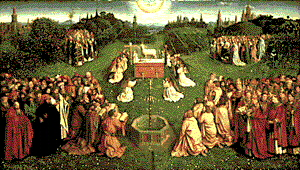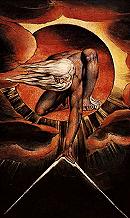 ND did those feet in ancient time ND did those feet in ancient time
Walk upon England’s mountains green? And was the holy Lamb of God On England’s pleasant pastures seen? And did the Countenance Divine Shine forth upon our clouded hills? And was Jerusalem builded here Among these dark Satanic mills? Bring me my bow of burning gold! Bring me my arrows of desire! Bring me my spear! O clouds unfold! Bring me my chariot of fire! I will not cease from mental fight, Nor shall my sword sleep in my hand Till we have built Jerusalem In England’s green and pleasant land.
— William Blake
Above: ‘Creation’ by William Blake
Below: Ghent altarpiece by Hubert and Jan Van Eyck

|
Commentary
 AD William Blake lived a few centuries earlier, I think he would have been one of the great medieval Catholic mystics, like the anonymous English author of The Cloud of Unknowing. But he was born after the Protestant heresies blighted ‘England’s green and pleasant land’, leaving him with nothing to fall back on but his own romantic longing: God-given talent and insight without the right outlet. (I think another famous free spirit, John Lennon, was a similar type.) The first stanza I think obviously refers to Catholic England, when ‘the holy Lamb of God’ was literally present in the Eucharist, but this also can refer to one of the legends of Glastonbury: that St Joseph of Arimathea once brought the boy Jesus to England. Also, the consequences of Western rationalism and humanism (of which the ‘Reformation’ was part) were literally ravaging the land and people with the Industrial Revolution Blake is attacking here (‘these dark Satanic mills’). His call to social action in the last stanza is a good one. (Ironically, the result of man-centredness was a dehumanizing of the culture.) AD William Blake lived a few centuries earlier, I think he would have been one of the great medieval Catholic mystics, like the anonymous English author of The Cloud of Unknowing. But he was born after the Protestant heresies blighted ‘England’s green and pleasant land’, leaving him with nothing to fall back on but his own romantic longing: God-given talent and insight without the right outlet. (I think another famous free spirit, John Lennon, was a similar type.) The first stanza I think obviously refers to Catholic England, when ‘the holy Lamb of God’ was literally present in the Eucharist, but this also can refer to one of the legends of Glastonbury: that St Joseph of Arimathea once brought the boy Jesus to England. Also, the consequences of Western rationalism and humanism (of which the ‘Reformation’ was part) were literally ravaging the land and people with the Industrial Revolution Blake is attacking here (‘these dark Satanic mills’). His call to social action in the last stanza is a good one. (Ironically, the result of man-centredness was a dehumanizing of the culture.)
The familiar music this poem is set to (many heard it at the end of the movie Chariots of Fire, and in the 1970s Emerson, Lake and Palmer recorded it) was written in 1916 by Sir Charles H.H. Parry, part of a revival of Anglican choral music (men and boys’ choirs in vestments) that was in part inspired by medieval Catholic models. (A small aside: the recent Billy Joel song ‘And So It Goes’ closely resembles this tune.)
|

